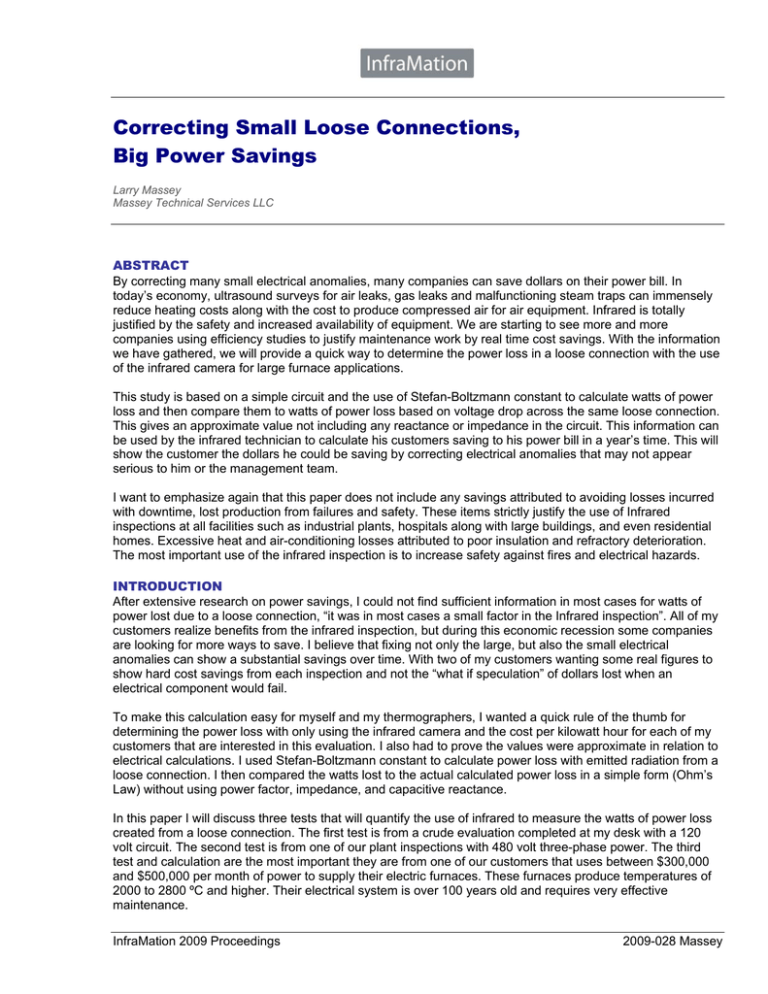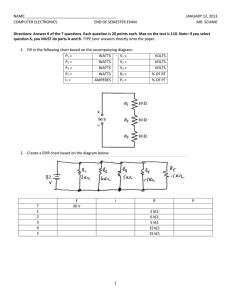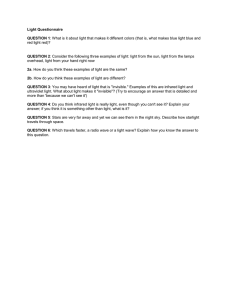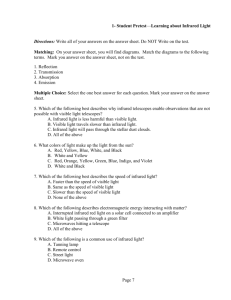Correcting Small Loose Connections
advertisement

Correcting Small Loose Connections, Big Power Savings Larry Massey Massey Technical Services LLC ABSTRACT By correcting many small electrical anomalies, many companies can save dollars on their power bill. In today’s economy, ultrasound surveys for air leaks, gas leaks and malfunctioning steam traps can immensely reduce heating costs along with the cost to produce compressed air for air equipment. Infrared is totally justified by the safety and increased availability of equipment. We are starting to see more and more companies using efficiency studies to justify maintenance work by real time cost savings. With the information we have gathered, we will provide a quick way to determine the power loss in a loose connection with the use of the infrared camera for large furnace applications. This study is based on a simple circuit and the use of Stefan-Boltzmann constant to calculate watts of power loss and then compare them to watts of power loss based on voltage drop across the same loose connection. This gives an approximate value not including any reactance or impedance in the circuit. This information can be used by the infrared technician to calculate his customers saving to his power bill in a year’s time. This will show the customer the dollars he could be saving by correcting electrical anomalies that may not appear serious to him or the management team. I want to emphasize again that this paper does not include any savings attributed to avoiding losses incurred with downtime, lost production from failures and safety. These items strictly justify the use of Infrared inspections at all facilities such as industrial plants, hospitals along with large buildings, and even residential homes. Excessive heat and air-conditioning losses attributed to poor insulation and refractory deterioration. The most important use of the infrared inspection is to increase safety against fires and electrical hazards. INTRODUCTION After extensive research on power savings, I could not find sufficient information in most cases for watts of power lost due to a loose connection, “it was in most cases a small factor in the Infrared inspection”. All of my customers realize benefits from the infrared inspection, but during this economic recession some companies are looking for more ways to save. I believe that fixing not only the large, but also the small electrical anomalies can show a substantial savings over time. With two of my customers wanting some real figures to show hard cost savings from each inspection and not the “what if speculation” of dollars lost when an electrical component would fail. To make this calculation easy for myself and my thermographers, I wanted a quick rule of the thumb for determining the power loss with only using the infrared camera and the cost per kilowatt hour for each of my customers that are interested in this evaluation. I also had to prove the values were approximate in relation to electrical calculations. I used Stefan-Boltzmann constant to calculate power loss with emitted radiation from a loose connection. I then compared the watts lost to the actual calculated power loss in a simple form (Ohm’s Law) without using power factor, impedance, and capacitive reactance. In this paper I will discuss three tests that will quantify the use of infrared to measure the watts of power loss created from a loose connection. The first test is from a crude evaluation completed at my desk with a 120 volt circuit. The second test is from one of our plant inspections with 480 volt three-phase power. The third test and calculation are the most important they are from one of our customers that uses between $300,000 and $500,000 per month of power to supply their electric furnaces. These furnaces produce temperatures of 2000 to 2800 ºC and higher. Their electrical system is over 100 years old and requires very effective maintenance. InfraMation 2009 Proceedings 2009-028 Massey CALCULATIONS In this paper we will use two equations: Ohm’s Law and Stefan-Boltzmann Law (Gray Body). Ohm’s Law simply stating that: Power Loss =V x A. This equation will be used for the measured calculations. Where: V = volts and A = amps. General information: “ [2] The analysis of three-dimensional heat transfer problems is extremely difficult. It is common to simplify the mathematics by considering a less complicated two-dimensional or onedimensional case. In a one-dimensional case, the conductive heat transfer is given by the Fourier law: Qcd= -k((dT(x,t)/dx)) where k is a material property called thermal conductivity. Thus, in a plate of thickness L with the stationary surface Temperature T1 and T2 where T2>T1, the rate of heat transfer is equal to Qcd = (T2-T1)/R where R is the thermal resistance, R=Lxk-1. Convection heat transfer is described in Newton’s law of cooling: Qcv = hcv(Ts-Tf) where Ts is surface temperature, Tt is fluid temperature and hc is convection heat transfer coefficient. The maximum radiation flux emitted by a blackbody is given by the StefanBoltzmann Law: Qrd = σ Ts4 where σ is the Stefan-Boltzmann constant. Gray bodies are characterized with emissivity E that varies from zero to unity and determines the energy emitted by radiation. We will be using unity in all examples”. Power Loss by IR Radiation = σ [(273+twarm)4-(273+tcool)4]. This equation will be used as the Infrared calculation. Where: t = temperature in Celsius. σ = Stefan-Boltzmann constant = 0.000000057 Watts/K4m2 We need to remember that the Stefan-Boltzmann constant is in Watts/(square meter) and not in Watts. The complete equation is given below. Radiative and Convective Power Loss = εσ(Thi4-Tlo4)A + hA(Thi-Tlo) where T is the absolute temperature, A the surface area, ε the emissivity, σ the Stefan-Boltzmann constant and h the convective coefficient. Conductive losses are neglected. One additional item to remember while you read is that our tests relate to thermal energy and some interesting facts can be found in the case studies. While temperature is related to thermal energy, there is no absolute correlation between the amount of thermal energy of an object and its temperature. Temperature measures the concentration of thermal energy in an object in much the same way that density measures the concentration of matter in an object. As a result, a large object will have a much lower temperature than a small object with same amount of thermal energy. Calculating the power loss from the Infrared imagery is difficult as one needs to know the surface area and the temperature of the surface. This is often very difficult to obtain on geometrically complex objects with large temperature gradients. But when the hot spot is due to a current flowing through a resistance, we can find the problem with Infrared and documentation of the power loss with Volts times Amps. Madding [1] has written a Watt loss calculation Excel Spreadsheet program that will do the math for you, provided you input the variables correctly. In the first test, conducted in our office we compared the Infrared calculation with the actual calculations and were close. When completing the second test I could not get the calculation to be close. This may be from the small area and my estimates of the area of the loose connection. The final test which are very important to me and my customer are close which is exactly what we need to prove to plant management that we can give them an approximation of the amount of dollars they are wasting by not correcting power feeds to their furnaces, and also creating a large amount of loss feeding each furnace causing the furnace not to reach full power. InfraMation 2009 Proceedings 2009-028 Massey FIRST TEST: OFFICE BENCH TEST Figure 1 shows the IR and digital image of the test completed in the office on a crude test bench. Figure 1. Thermogram/photo pair showing the test bench example of 120 volt circuit with a hair dryer. Using the Infrared calculation we calculate 1.2 watts of power lost at the loose connection. Using the Ohm’s law with voltage drop across the loose connection of 0.38 volts and a current 5.6 amps thru the circuit we get 2.13 watts of power lost at the loose connection. This test example does not prove a close relationship between the Infrared calculation and the calculated power loss, probably due to difficulty in estimating the area losing heat plus unaccounted heat lost by conduction through the wires. This example does not show any benefit from power loss to justify an infrared inspection except for the loose connection that has a high potential of a fire hazard which is major safety issue at every location. SECOND TEST: PLANT INSPECTION TEST Figure 2 shows the IR and digital image of a test completed at one of our customer locations on a three phase 480 volt circuit to a motor. This test was completed with a low delta T to compare the infrared temperature calculations with the actual calculations. Figure 2. IR and photo pair showing thermal anomaly on motor circuit. Using the Infrared calculation we calculate 0.2 watts of power lost at the loose connection. Using the Ohm’s law with voltage drop across the loose connection of 0.102 volts and a current of 24.9 amps through the InfraMation 2009 Proceedings 2009-028 Massey circuit we get 2.53 watts of power lost at the loose connection. This test example does not show a close relationship between the Infrared calculation and the calculated power loss. This example does not show any benefit from power loss to justify an infrared inspection except for the loose connection that has a potential of a future loss of production or fire hazard. Both are major issues and justification for infrared surveys even with the low delta temperature change. THIRD TEST: PLANT WITH MULTIPLE FURNACES TEST In the next few examples we will be comparing the Watts lost by Infrared to the calculated Watts lost. A general overview of the plant is necessary to understand the importance of this project leading to this paper. The plant is over 100 years old, but by being efficient they are a valued part of our market place in the US and Global market place now and in the future. The power system feeding the furnaces is 2300 volts single phase from multiple control tapped transformers for each building with 8” by ½” parallel bars feeding each furnace from a feeder setup as shown in Figure 3. Each building may house up to 24 furnaces. Each furnace is approximately 14’ by 50’ long. Each building is supplied by two or four booster units for start up and then parallel units for maximum fire. The booster transformers are 1 megawatt each and the parallel transformers are 2 megawatts each. The booster transformers feed the furnaces from a trough in the ground and the main parallel transformers supply power to the furnaces from overhead copper bars. The 2300 volts is reduced to an output of 30 to 100 volts and potential current of 3000 to 4000 amps to each furnace. During our tests the voltage drops and currents were measured by plant engineering. Measurements were made with a volt meter and a flexible CT to go around the copper bar connections. I will show that the infrared measurements for power loss will be close to the actual calculated values. The plant has multiple buildings with multiple furnaces for different orders. This company provides graphite material sales on a global scale. By providing a cost per hour savings we can help our customer to plan their maintenance work where it is most effective. Figure 3. Example sketch of a furnace building with booster and main transformers. Figure 4 shows the IR and digital image of a test completed at one of our customer locations on a single phase booster feed to one large furnace. InfraMation 2009 Proceedings 2009-028 Massey 8X14 8X8 Voltage drop 0.41 volts. 3371 amps Figure 4. Thermogram/photo pair showing the copper connection with an anomaly on the right phase. Below are the calculations for this comparison, along with the size of the copper bars between the points measured for the voltage drop. The remaining locations will only have the comparison values. Copper bars are two parallel bars one set of measurements was taken to the right at 8” X 14” and the second set was vertical at 8” X 8”. Power Loss = using the Excel spreadsheet by Madding = 1566 watts. Power Loss = V x A = 0.41x3371 = 1383watts. Energy cost for this plant is 3.9 cents per KW hour. Cost/hr = ($/KWH) X Watts/1000. In the example above using the 1566 watts and their average cost per KWH, a loss of $0.06 per hour is shown. This is a small amount but, we cannot forget that is only one loose connection in the circuit for one furnace. Plant engineering using their collected data cleaned and tightened one bad connection and then retested the new data at the same amperage. The correction showed a savings of $0.07 per hour of run time. Plant engineering corrected 6 connection problems at different locations and showed a $0.44 per hour savings. Figure 5 is a second example in which the infrared calculated watts vs. the measured watts were compared. 8 X 14 8X8 Voltage drop 0.51 volts. 3316 amps Figure 5. Thermogram/photo pair showing the copper connection with an anomaly on the left phase. InfraMation 2009 Proceedings 2009-028 Massey Calculated power loss with infrared = 1838watts Calculated power loss with measurements = 1691watts Figure 6 is a third example to compare the infrared calculated watts vs. the measured watts. The Infrared picture was tough to get in focus; water was running over the connections to help keep them cool. The water also may change our Infrared calculated watts. 8X8 8X12 Voltage drop 0.94 volts. 3450 amps Figure 6. Thermogram/photo pair showing the copper connection with an anomaly on the right phase. Calculated power loss with infrared = 3720 watts Calculated power loss with measurements = 3243 watts Both of these power loss calculations will be near a $0.12 per hour loss at the present cost per KWH with the new proposed power increase this would push electrical loss to near $0.13 per hour and this is just a calculated approximate figure for only one loose connection in the series single phase circuit. We are not considering any power factor changes, transformer impedance or reactance. SUMMARY From our study we proved the obvious that Infrared is generally used as a maintenance tool for finding anomalies that may and will cause catastrophic equipment failures, loss of production, potential for fires and the general environmental safety. Infrared imaging is the best tool for any maintenance force or consultant. We showed that we must use an ambient radiant reference of the surrounding area and not a similar material in the same circuit for our calculations to be close. And close is all we need for this project to help our customer. Using average temperature instead of maximum temperature in some cases made the power loss closer, but I wanted to use maximum temperature until we have more baseline data. We also showed that for this particular furnace design, that Infrared can also approximate a large amount of power being lost from loose connections, and the potential for excessive efficiency loss in the furnace when trying to reach maximum fire for a product, extended fire time and additional cost. These are the items that must be eliminated in today’s economy. We determined that the radiant energy from other sources in the area must be considered to get an exact loss of watts. It was apparent that we must also us a correct emissivity for a true calculated Infrared watts lost at the loose connection. We also showed that when measuring small areas and areas with different emissivity’s the power loss at the loose connection may be off. I feel the use of the Madding [1] Excel program is the quick way to determine the watts lost in a high amperage situation similar to our last examples. InfraMation 2009 Proceedings 2009-028 Massey This Infrared procedure can be used as a quick way to determine the improper connections associated with copper bars in an electrical furnace. And most important to show a quick dollar amount to management so they can implement corrective actions as soon as possible. REFERENCES 1. Robert Madding, Excel spreadsheet program for power loss in Watts. 2. Nondestructive Testing Handbook Volume 3, Infrared and Thermal Testing. Technical Editor Xavier P.V. Maldague. Editor Patrick O. Moore. ACKNOWLEDGEMENTS The author wishes to thank the Infrared Training Center at FLIR Systems for their training, and the excellent FLIR equipment. Many thanks to Dr. Robert P. Madding, former Director Infrared Training Center, FLIR Systems, Inc. I would also like to thank my customers for providing the resources to make this work possible. ABOUT THE AUTHOR Larry is a Level I thermographer, and has been using the technology for over 8 years in all types of industries. Larry is a Level III vibration analyst and has a background in electrical and mechanical engineering. Larry has worked in the shipbuilding and mining industries for over 30 years, with additional maintenance experience in the plastic and graphite industries. InfraMation 2009 Proceedings 2009-028 Massey InfraMation 2009 Proceedings 2009-028 Massey






